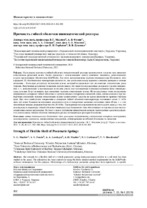| dc.contributor.author | Маслиев, В. Г. | |
| dc.contributor.author | Фомин, А. В. | |
| dc.contributor.author | Ловская, А. А. | |
| dc.contributor.author | Маслиев, А. О. | |
| dc.contributor.author | Горбунов, Н. И. | |
| dc.contributor.author | Дущенко, В. В. | |
| dc.coverage.spatial | Минск | ru |
| dc.date.accessioned | 2021-07-20T08:01:13Z | |
| dc.date.available | 2021-07-20T08:01:13Z | |
| dc.date.issued | 2021 | |
| dc.identifier.citation | Прочность гибкой оболочки пневматической рессоры = Strength of Flexible Shell of Pneumatic Springs / В. Г. Маслиев [et al.] // Наука и техника. – 2021. – № 4. – С. 302-309. | ru |
| dc.identifier.uri | https://rep.bntu.by/handle/data/97667 | |
| dc.description.abstract | Исследована прочность гибкой оболочки пневматической рессоры транспортного средства при движении относительно рельсовой колеи. Расчет проведен с использованием метода конечных элементов, реализованного в среде программного обеспечения SolidWorks. Для этого воспроизведены чертежи пневморессоры баллонного типа в формате 3D. Особенностью конструкции является то, что расстояние между верхним и нижним днищами в статике неизменно – благодаря регулятору положения кузова, который поддерживает его постоянство относительно рамы тележки. Полученные результаты позволили сделать вывод, что имеются определенные резервы по уровню напряжений, т. е. дополнительно к вертикальным возможно учесть еще и поперечные взаимные смещения днищ пневморессоры, которые будут возникать при смещениях тележки относительно кузова. На последующем этапе исследованы напряжения в материале гибкой оболочки в случае взаимных поперечных смещений днищ, наблюдающиеся при поперечных смещениях тележек относительно кузова транспортного средства во время движения по кривым участкам пути. При этом наибольшие напряжения в материале гибкой оболочки пневморессоры составляют около 11 МПа даже при вдвое большем номинальном давлении воздуха и поперечных взаимных смещениях днищ 40 мм, т. е. они значительно меньше разрывной прочности (30 МПа). Проведенные исследования позволяют сделать вывод о том, что конструкция и параметры гибкой оболочки пневморессоры баллонного типа обеспечивают ее прочность при эксплуатационных схемах нагружения. Поэтому с целью улучшения динамических качеств транспортных средств предлагается использовать гибкую оболочку пневморессоры как составляющую рессорной подвески. | ru |
| dc.language.iso | ru | ru |
| dc.publisher | БНТУ | ru |
| dc.title | Прочность гибкой оболочки пневматической рессоры | ru |
| dc.title.alternative | Strength of Flexible Shell of Pneumatic Springs | ru |
| dc.type | Article | ru |
| dc.identifier.doi | 10.21122/2227-1031-2021-20-4-302-309 | |
| local.description.annotation | The strength for a flexible shell of a vehicle pneumatic spring during movement relative to a rail track has been studied in the paper. The calculation has been carried out using the finite element method implemented in the SolidWorks software environment. For this purpose, 3D drawings of a balloon-type pneumatic spring have been reproduced. A specific feature of the design is that the distance between the upper and lower bottoms in static conditions is unchanged – thanks to the body position regulator, which maintains its constancy relative to the trolley frame. The results obtained have made it possible to conclude that there are certain reserves for the level of stresses, i.e., in addition to the vertical, it is possible to take into account also transverse mutual displacements of the air spring bottoms which will occur when the trolley moves relative to the body. At the next stage, the stresses in the material of the flexible shell are investigated for mutual transverse displacements of the bottoms, which are observed with transverse displacements of the trolleys relative to the body of the vehicle when traveling along curved sections of the track. At the same time, the maximum stresses in the material of the flexible shell of the pneumatic spring are about 11 MPa, even with twice the nominal air pressure and transverse mutual displacements of the bottoms of 40 mm, that is, they are much less than the breaking strength (30 MPa). The carried out researches allow to draw a conclusion that the design and parameters of a flexible shell of a balloon-type air springs ensure its strength under operational loading schemes. Therefore, in order to improve the dynamic qualities of vehicles, it is proposed to use a flexible shell of a pneumatic spring as a component of the spring suspension. | ru |

